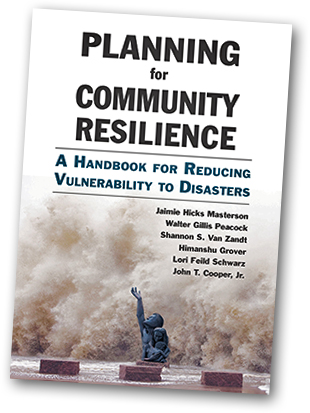Profs publish book of steps to increase community resilience
Lean more about the new book, “ [Planning for Community Service] (http://islandpress.org/planning-community-resilience) ,” co-authored by four urban planning educators and a former student.
Procedures to create resilient communities — places that avoid, absorb and recover quickly from natural disasters — are detailed in a new book co-authored by four urban planning educators at Texas A&M’s College of Architecture.
 The book, “
[Planning for Community Resilience]
(http://islandpress.org/planning-community-resilience)
,” shows how communities can lower their risks from physical and social hazards by assessing their vulnerabilities and creating a plan to address them. Resilience, the authors point out, depends on planning that considers all populations in the community.
The book, “
[Planning for Community Resilience]
(http://islandpress.org/planning-community-resilience)
,” shows how communities can lower their risks from physical and social hazards by assessing their vulnerabilities and creating a plan to address them. Resilience, the authors point out, depends on planning that considers all populations in the community.
Disaster resiliency is a crucial issue for communities everywhere, said co-author Walter Gillis Peacock, director of the university’s [Hazard Reduction & Recovery Center] (http://hrrc.arch.tamu.edu) .
“The number of natural disasters occurring annually has more than doubled globally since 1980,” he said. “These catastrophes are increasing in number and magnitude, causing greater damage from rising sea levels and other effects of climate change.”
The book, based on HRRC research of Galveston’s recovery from Hurricane Ike in 2008, is intended for city planners, elected officials, floodplain managers, natural hazard managers, planning commissioners, local business leaders and citizen organizers.
The books coauthors are John Cooper, associate professor of practice in the [Department of Landscape Architecture and Urban Planning] (http://laup.arch.tamu.edu) , Jaimie Hicks Masterson, program coordinator for the [Texas Target Cities] (http://ttc.arch.tamu.edu) program, Shannon Van Zandt, director of the [Center for Housing and Urban Development] (http://ttc.arch.tamu.edu) , and Himanshu Grover, an assistant professor of urban planning at the University of Buffalo who earned a Ph.D. in [Urban and Regional Science] (http://laup.arch.tamu.edu/academics/graduate/ursc/) at Texas A&M in 2010.
Tags
- climate
- coastal systems
- environment
- feature
- hazard reduction & recovery
- hazards
- land development
- landscape architecture & urban planning
- planning
- rss
- sustainability
- texas target communities
- ttc
- urban systems
Related Posts
JAPA features 4 papers by TAMU disaster researchers

Planning prof presents hazard mitigation ideas
Nation's safety enhanced by resiliency studies

Study eyes how lower Lake Conroe levels impact economy
Follow Us
Facebook Twitter Vimeo Youtube Flickr RSS
Recent Posts

Planning prof heads study of disaster housing aid

A message from the dean

Former student remembered as expert planner

Leading educator named new head of Architecture Dept.





_thumbnail_small.png)
